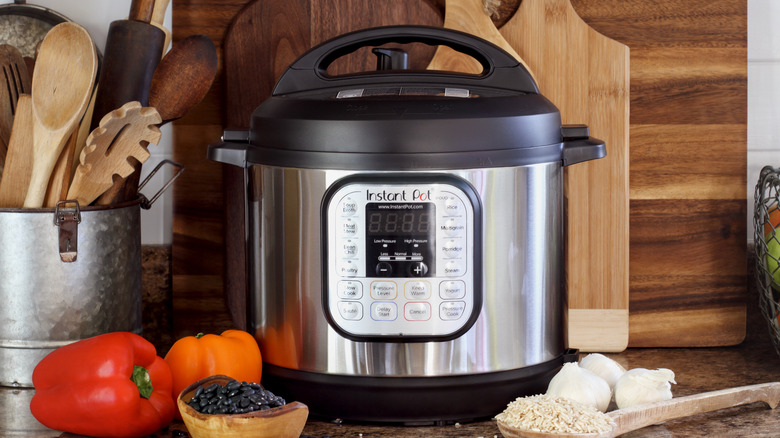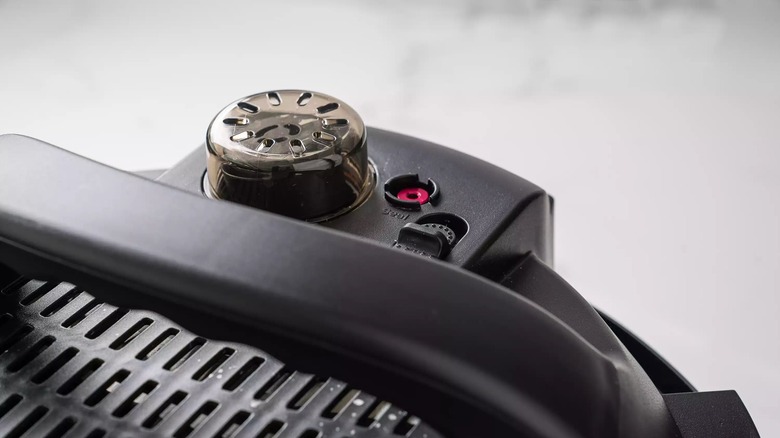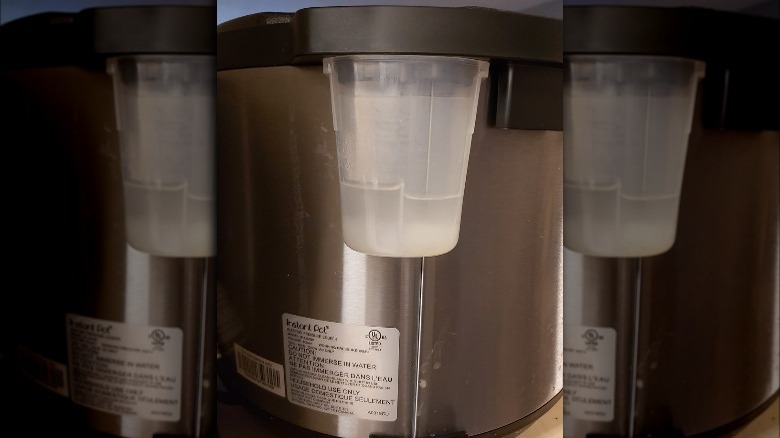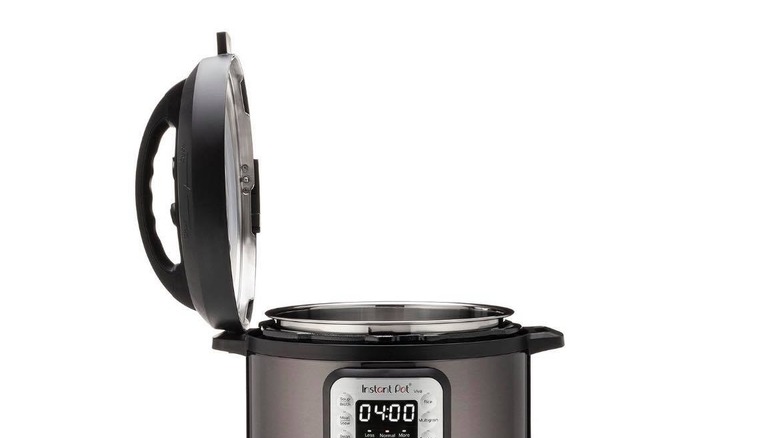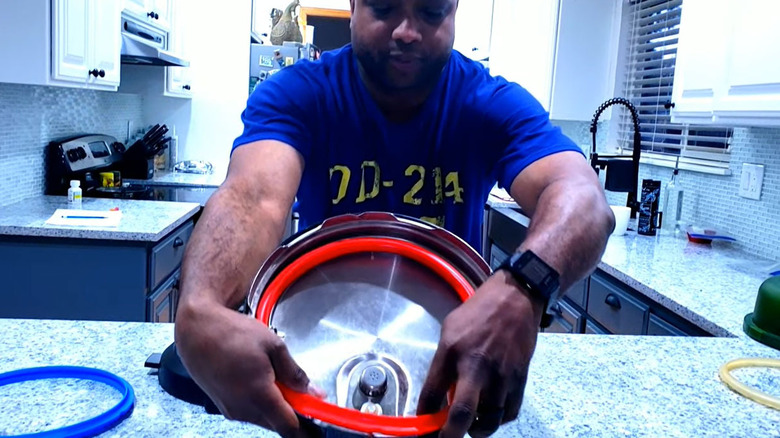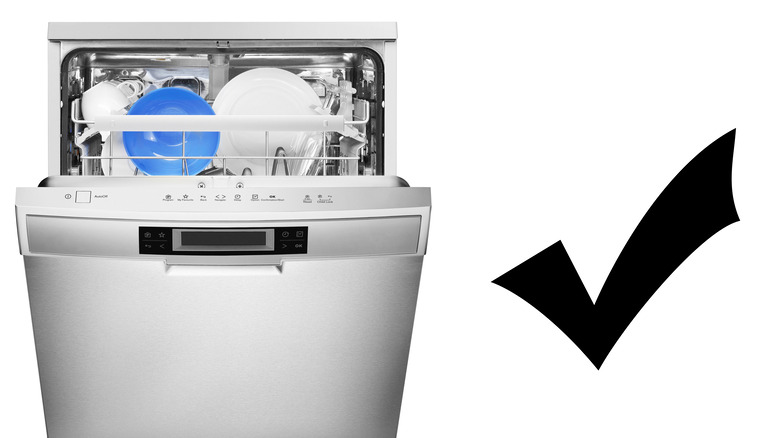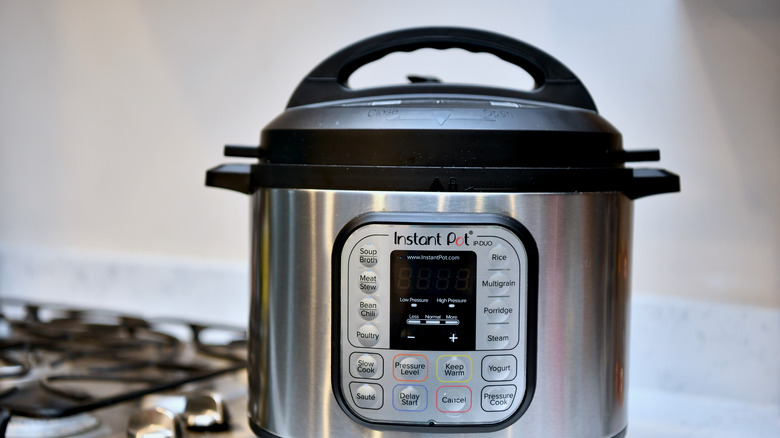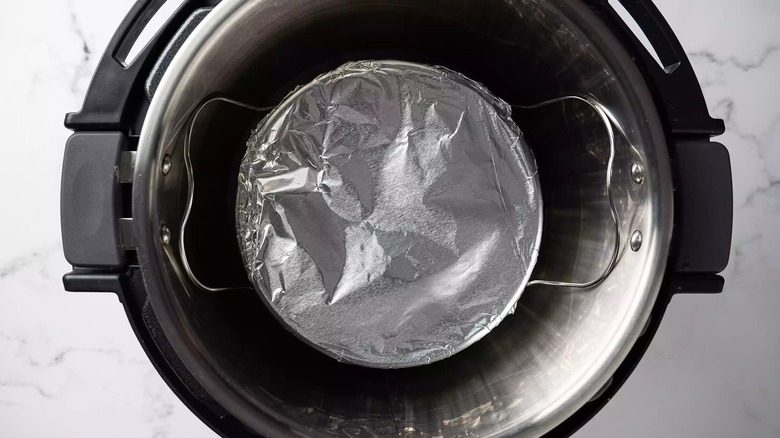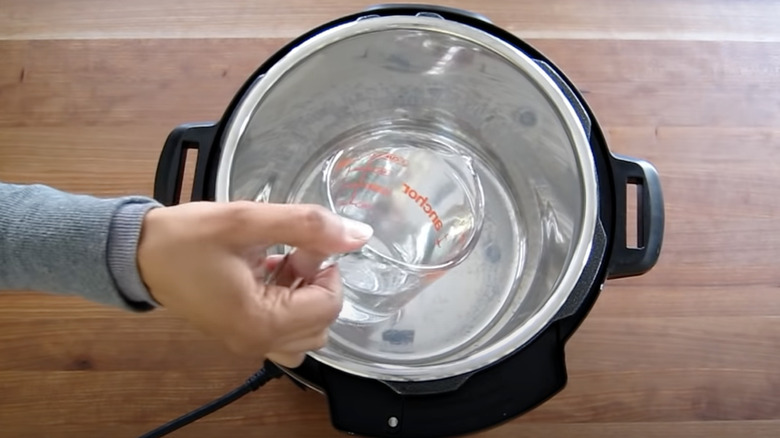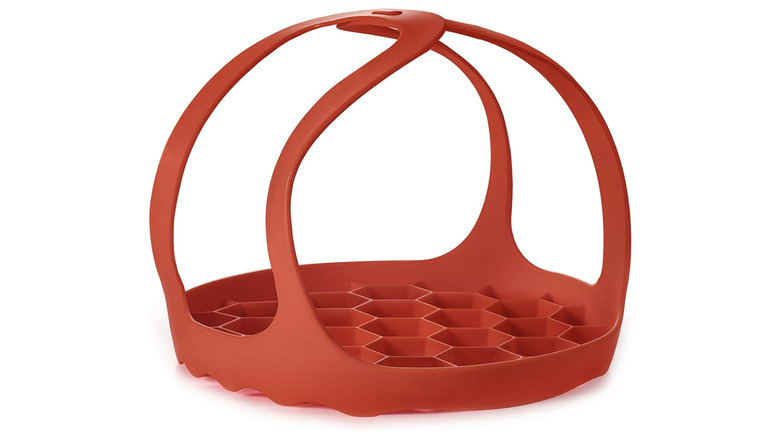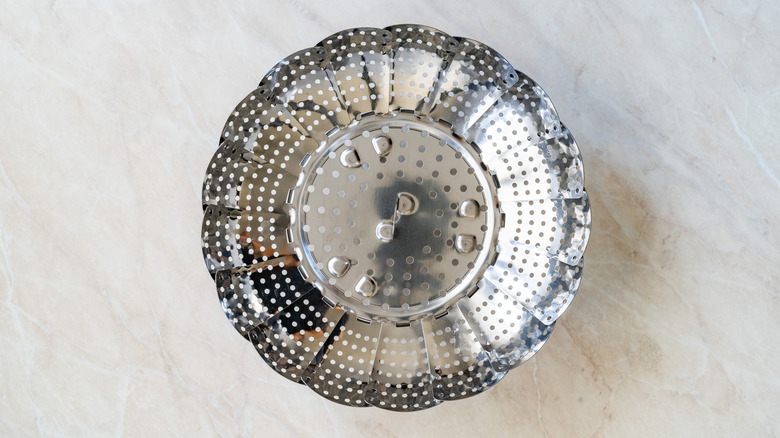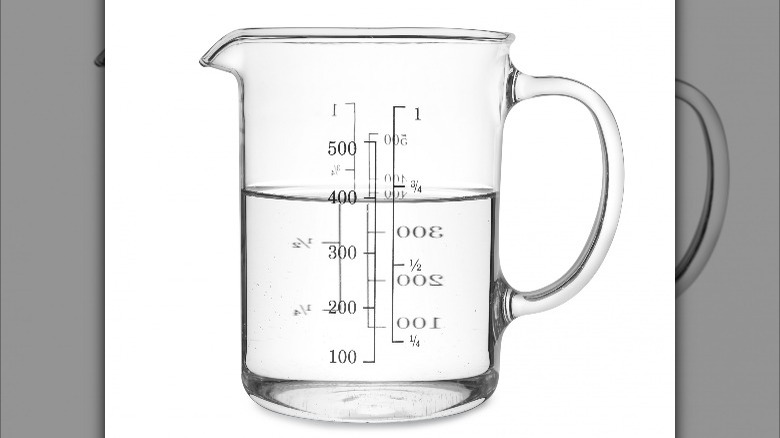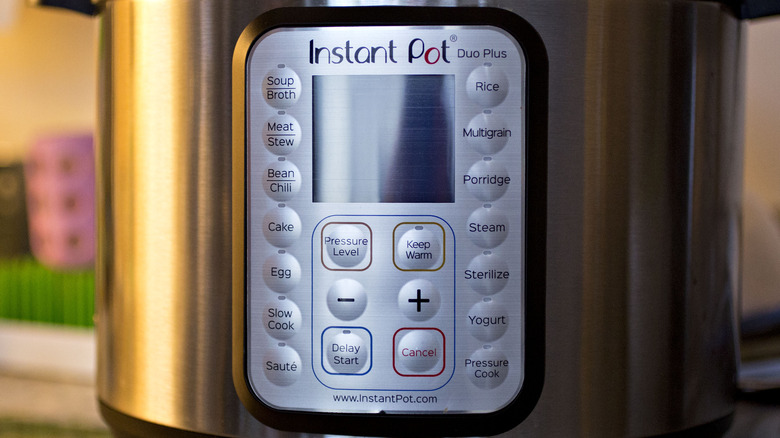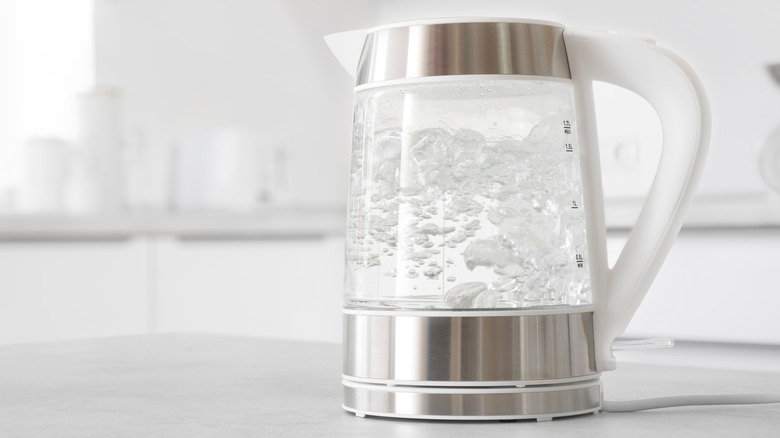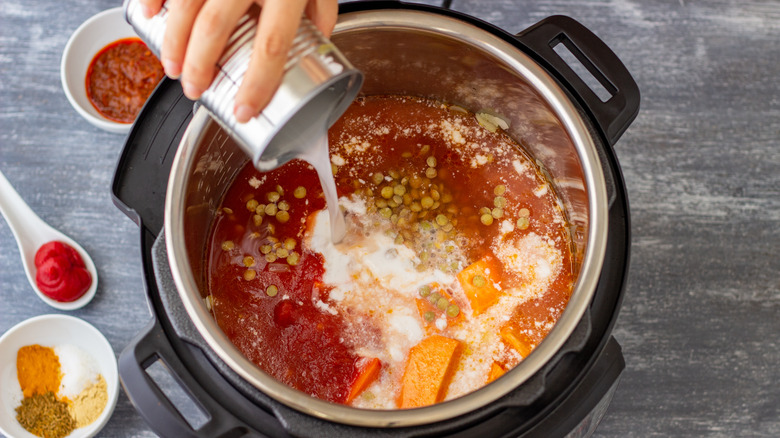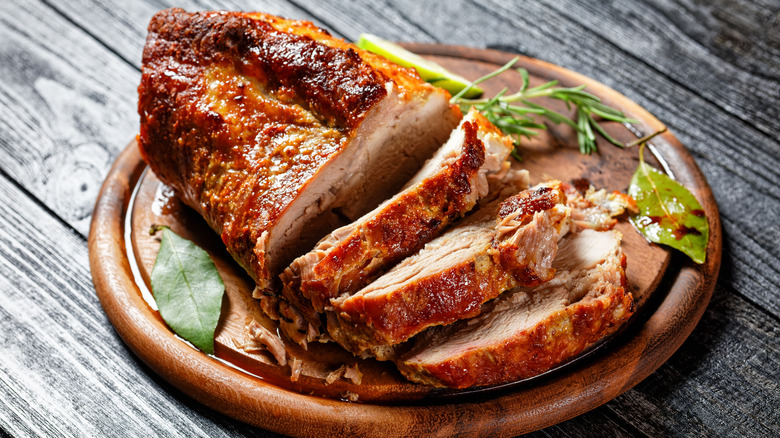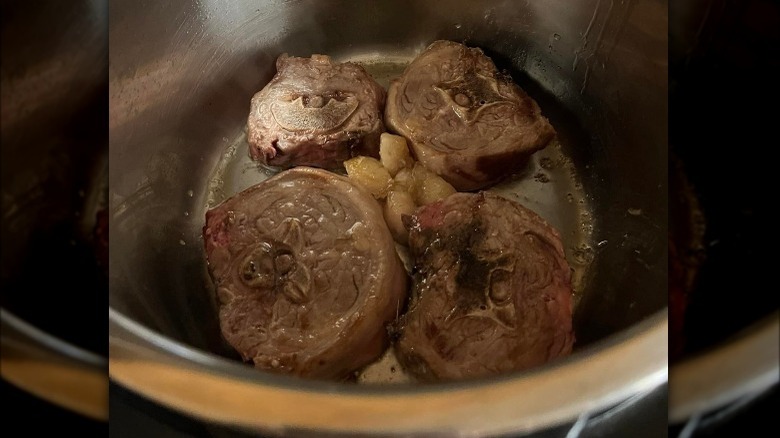20 Tips You Need When Cooking With An Instant Pot
We may receive a commission on purchases made from links.
When Canadian telecommunications specialist Robert Wang found himself out of work in 2008, he decided to pursue his dream of becoming the "Steve Jobs of kitchen appliances" (via CNBC). Inspired by the electric pressure cookers that were already popular in China, he spent over a year perfecting the product that became the first version of the Instant Pot. Though sales were slow initially, he believed in his vision, and over the course of a few years, his multi-cooker became an internet sensation. The little gadget can do just about anything, from delicious chicken broth to oatmeal to cheesecake.
If you're new to team Instant, you might not know where to start. Pressure cooking can be intimidating, especially when there are so many myths floating around online. Once you get the hang of it, you'll be pumping out tasty, easy meals in no time. These tips will help you keep your Instant Pot running like new no matter how much you use it. Even if you're a pressure cooking pro, you'll find a couple of useful hints you didn't know before.
You shouldn't use the quick pressure release for everything
There are two ways to release the pressure from your Instant Pot after your food is done. The fastest way to do this is by hitting the quick release switch. This will cause a jet of steam to shoot out of the pressure valve of your Instant Pot. This method is great because it allows you to open the lid safely within a couple of minutes, but it's not a good choice for some cooking applications. Liquid-heavy preparations like stock that require filling the pot to the max fluid line can cause hot broth to shoot out of the release vent, which can make a big mess and force you to deep clean your pot's lid.
The quick-release is also dangerous for starchy foods like oatmeal that make a lot of foam during the cooking process (via Pressure Cooking Today). This foam can ooze out of the steam vent during quick release. The fast temperature loss that occurs during depressurization may also make braised meats tougher. For all of these applications, natural release, where you simply wait for the food to cool down on its own, will give you better results and won't spray liquid all over your kitchen. If you don't want to wait that long, opt for a hybrid technique and let your food sit for around 10 minutes before hitting the release switch.
Don't forget to clean the condensation cup
Most models of Instant Pot come fitted with a small plastic cup that's meant to collect the condensed steam that the pot produces during cooking (via Miss Vickie). It's not strictly necessary, but it's nice to not have to wipe a little puddle off of your counter every time you use your pressure cooker. It's such a minor part of the Instant Pot experience that it's easy to forget it's there. Don't sleep on your condensation cup though, because not cleaning it could have dire consequences.
Darcy Lenz from MyRecipes relates a terrifying experience her friend had when they failed to clean their damp condensation collector. A full colony of ants had taken up residence in the cup, feasting on the starchy water that had collected from repeated Instant Pot use. It's like something out of a horror movie.
Be careful about the steam
The geyser of steam that ejects from your Instant Pot when it loses pressure is really hot, so you should be careful not to accidentally stick any body parts in its path. The hot steam can also wreck your kitchen cabinets if you're not careful. If you habitually use your pressure cooker on an area of the counter underneath your kitchen cabinets, the moisture from the steam can damage them over time (via One Happy Housewife). Wood and paint are particularly susceptible to this kind of moisture damage.
You might want to try putting a towel over the vent to control the flow of steam, but Instant Pot's manufacturer warns that covering the vent could potentially lead to an explosion (via Hip Cooking). If your kitchen is set up in a way that makes it difficult to vent steam safely, consider buying a steam diverter. These redirect the flow of the steam so it shoots sideways instead of straight up. Some of them even look like fun dragons! You should always be careful when using these accessories, however, as the Instant Pot was not originally designed to work with them.
The Instant Pot comes with its own lid holder
The lid of an Instant Pot has to be big and bulky to withstand the high pressure inside the cooking vessel and to accommodate the pot's numerous safety features. After cooking, the underside of the lid gets covered in condensation that can spill all over your counters. It's hard to figure out where to stash the lid without making a mess.
Instant Brands realized this was a potential issue and included an ingenious solution into the design of their cooker. The handles of the Instant Pot base have holes that are the exact size of the lid's handles (via Lifehacker). When you open your Instant Pot, you can stick the lid handle into one of the base handles and it will hold the lid in place. You don't have to haphazardly toss the lid on the counter, spilling water everywhere. The lid holding system keeps everything in a tidy, compact package.
You need to replace the sealing ring on your Instant Pot regularly
The sealing ring is key to ensuring that your Instant Pot works the way it should. Miss Vickie writes that the sealing ring prevents pressure and liquid from escaping the cooking vessel and causing messes or even explosions. The sealing ring on an Instant Pot is made from silicone, which is ideally suited to the purpose because it's heat resistant and flexible. Silicone's pliability means that the sealing ring is less durable than the rest of the Instant Pot, which is made out of sturdy hard plastic and stainless steel. You want to avoid having a sealing ring fail on you in the middle of cooking, so it's a good idea to replace it periodically.
Consider buying a new sealing ring every year or so and replacing it more frequently if you're a heavy Instant Pot user. Given how crucial the ring is to your pressure cooker's functioning, it's a good idea to keep an extra ring stashed away somewhere in case of disaster.
If the 'burn' error comes on, you can still save your food
Seeing the dreaded "burn" error message on an Instant Pot's screen can send even a seasoned pressure cooker master into conniptions. You might be afraid that your pot is filled with the charred remains of a perfectly good pot roast, but in all likelihood, you can salvage your food before it turns into charcoal. The "burn" error appears when your Instant Pot senses that food has started to stick and burn to the bottom of the pot. This usually happens either because you're trying to cook with too little liquid or because your liquid is too thick.
To fix a "burn" error, first hit "cancel" so the Instant Pot stops cooking. Then, vent the pressure so you can open the lid and access the food. Oftentimes, the error message comes on before anything burns too badly. Stir your food around and add at least a half cup of water or stock, and you should be safe to reattach the lid and continue cooking. If food has stuck to the bottom of the pan, use something sturdy to scrape the crust off so it doesn't trip the sensor again.
You can wash the whole Instant Pot lid in the dishwasher
Every part of your Instant Pot besides the base and the power cord is dishwasher-safe, and that includes the entire lid. LifeSavvy says that the lid can handle top-rack dishwasher cleaning as long as you disassemble it before it goes in the washer. Just remove the sealing ring, anti-block shield, and float valve, and your lid is ready for the dishwasher. The parts you removed are also technically dishwasher safe, but unless your washer has some kind of rack that can prevent the tiny pieces from flying around, you might prefer to hand-wash them.
The Instant Pot base isn't safe to put in the dishwasher because of its delicate electronic components. You should also avoid washing it in the sink or using any more moisture than a damp rag to clean it. Water could short out the Instant Pot's digital brain or corrode its heating elements, diminishing its cooking ability. If you need to deep-clean the base for some reason, a small, stiff brush like a toothbrush should be able to scrub off any offending grime.
The Instant Pot's lightning-fast cook times are a little misleading
The Instant Pot boasts some impressively quick cook times, especially for smaller vegetables and cuts of meat. According to Paint The Kitchen Red, the machine can cook asparagus in zero minutes at high pressure. Broccoli also apparently cooks in zero time, and shrimp only takes one minute. These miraculously speedy times come with a big caveat: they're the time it cakes to cook something once the Instant Pot has come up to pressure. It generally takes at least 10 minutes for the appliance to pressurize, longer if you're cooking a high volume of food or if your ingredients are frozen. Then you have to release the pressure to access your food, which can take up to half an hour if you're using the natural release. Suddenly, that zero-minute broccoli has turned into 45-minute broccoli.
For this reason, it's generally a good idea to save your Instant Pot for recipes that would normally take a long time. The Instant Pot makes foods like homemade stock, dried beans, and large chunks of braised meat all take minutes rather than hours to cook. For little things like steamed vegetables and chicken breasts, you won't save much time or energy by using the Instant Pot instead of conventional methods.
If your sealing ring is getting stinky, steam it with vinegar
The silicone sealing ring on your Instant Pot is slightly porous, and it tends to hold on to the odors of the food cooked inside the pot. If you wash it promptly after each use, the smell shouldn't build up, but if you've been neglecting your ring then you might need to deep clean it. Fortunately, you can use your Instant Pot's steam function to blast the odor out of your sealing ring and make it smell like new.
The process for steam cleaning your ring is simple, fast, and cheap. Fill your pot with a couple of cups of white vinegar (or water and a lemon rind if you don't like the vinegar smell). Seal the lid with the offending silicone ring and hit the "steam" button. Cook for two minutes, unseal, and rinse the ring in clean water. Voila! The smell of last week's Instant Pot pot roast recipe should be completely gone. If you use your Instant Pot for both sweet and savory foods, the Food Network notes that it's a good idea to use two different sealing rings so you don't get any unwanted flavor contamination.
You can cook multiple things at once with the pot-in-pot method
If you're as in love with your Instant Pot as everyone else who owns one is, you'll want to use it to prepare as many dishes as you can. Sadly, the device's design limits you to cooking one thing at a time. Or does it? Clever Instant Pot obsessives have figured out a hack for cooking two separate dishes at once: the pot-in-pot method.
Once a Month Meals delves into the secrets of the pot-in-pot hack, and it's actually pretty simple. First, you add a base layer of food, normally a grain like rice. You add water to the rice like you normally would, and then you place a small pot or heat-proof bowl on top with a different food inside. Close the lid and cook as usual, and you'll be rewarded with a main dish and a side prepared at the exact same time. You can create little handles out of aluminum foil to help lift out your little pot when the food is done. The pot-in-pot method isn't just for cooking two things at once either. You can also use it to reheat frozen meals or cook things that don't have enough liquid for the Instant Pot. Just fill the bottom of the Instant Pot with water, add a steamer basket or trivet, put the little pot on top, and cook.
Do a water test before you cook anything
While the Instant Pot is a good, reliable product, you still want to make sure it works properly before you start loading any real food into it. You don't want a half-cooked pot roast and a pint of gravy splattered all over your kitchen walls, do you? A simple water test will let you know everything is in order before you start cooking. You only need to do this once; after that, you can assume your pot is functional.
Per the instructions on the Instant Pot website, to do this initial test, all you need to do is fill the inner pot with three cups of water, pressure cook on high for five minutes, and then initiate a quick release. This tests whether the pot comes up to temperature and holds pressure. It also ensures that the pressure release valve is working as it should and lets you know that the "warm" function will kick in after cooking is complete.
Replace the trivet with an aftermarket one
The trivet is the little wire contraption that came with your Instant Pot. It's used to cook things that you don't want to be submerged in water. This can be anything from a dessert such as cheesecake or a large roast like a whole chicken. It's also the best way to cook hard-boiled (actually steamed) eggs in your Instant Pot.
While the trivet is an incredibly useful accessory, we don't love the ones that are bundled with Instant Pots. They're made out of stainless steel, which could potentially scratch the inner pot. Furthermore, that metal can get ripping hot during the cooking process. This can make it hard to use the trivet's handles to lift your food out of the pot. Finally, the legs on Instant Pot trivets are kind of stubby, so you have to be careful about using enough water to allow the pot to come up to pressure, but not so much that it will touch your food.
Given all these problems, an upgraded trivet will be your friend. There are several good options, including silicone ones that won't burn your hands or damage your pot.
Use a steamer basket for delicate foods
Another shortcoming of the standard Instant Pot trivet is that it has wide gaps. You can theoretically use the trivet for steaming, but you're limited to foods that are large enough to not slip through the cracks. In order to prevent this, you should use a steamer basket like this official Instant Pot model. Since the basket is made out of a relatively fine mesh, you won't have to worry about bits of food ending up in your cooking liquid.
A steamer basket like this is a worthwhile investment because steaming is the absolute best way to prepare certain foods in an Instant Pot. As Miss Vickie writes, delicate proteins like fish, shrimp, and chicken breast are all great candidates for steaming. Steamed vegetables also turn out well when cooked in the Instant Pot, and their flavor and nutrients don't leach out into the cooking liquid like they do when they are boiled.
Stop using too much water in your Instant Pot
According to the official manual for the Instant Pot Duo series from 2018, you need at least 18 fluid ounces, or a little over two cups, of water for your pressure cooker to work. Per The Veggie Queen, the company has since revised this down to one cup. Be advised that if you try to cook with less water than that, you are going against the manufacturer's recommendations, and you are doing so at your own risk. However, you may find that you need significantly less than one cup of water to pressure-cook certain ingredients.
As The Veggie Queen explains, many types of vegetables have a high water content and much of that moisture gets released during the cooking process. That means you can get away with only adding a little bit of water to the pot when pressure-cooking them. The blog mention mushrooms, zucchini, and soaked beans specifically as falling into this category, but there are plenty of other vegetables with a lot of inherent moisture.
Leave most of the buttons alone
The front of an Instant Pot is covered with a dizzying array of buttons. Depending on the model, you'll see buttons labeled "bean/chili," "soup/broth," "cake," "porridge," and more. While some buttons, like "yogurt," actually make the pot cook in specialized ways, the majority of them just make the appliance cook on high pressure for a set amount of time that the Instant Pot has decided will work well for the type of food printed on the button (via Pressure Cooking Today).
As anyone who has used the "popcorn" button on a microwave and been rewarded with a charred mess knows, the cooking presets in appliances are estimates at best. Pressure Cooking Today explains that for the vast majority of pressure cooking recipes, all you need is the "manual/pressure cook" button. Any recipe you find will likely give you a specific cooking time for the dish you're making, so you can just use that button to set the exact time yourself. The other two buttons that will see a lot of use are "sauté," which is useful for browning meat or pre-cooking vegetables, and "keep warm/cancel," which is the Instant Pot's off switch.
Start with hot water to cut down your cooking time
A big percentage of the overall cooking time for pressure-cooked dishes in the Instant Pot is taken up by bringing the contents of the pot up to a high enough temperature and pressure. It therefor makes sense that you can dramatically reduce this time by adding your liquid to the pot when it's already hot. The heating element in an Instant Pot will certainly do the job of heating up your food, but a good kettle or even a pot on the stove will boil water faster than your Instant Pot will.
A Reddit thread confirms this assumption. One poster adds that you can even use the sauté function to preheat your liquid before starting to cook under pressure. This could be a great way to multitask, as you can start preheating your broth/water/whatever while you chop and prep the other ingredients for your dish.
Don't overfill your Instant Pot
When cooking under pressure, it's important to follow all the necessary safety precautions — you don't want an explosive situation on your hands. The Instant Pot's manufacturer says that you can only fill the inner pot a maximum of two-thirds of its total volume. (Conveniently, this maximum fill line is marked on the inside of the pot.) Some foods, like grains and beans, either expand dramatically during the cooking process or have a tendency to splatter and foam. For these foods, you should only fill the pot halfway up, as the foam can clog your Instant Pot's release valve.
But what happens if you overfill a pressure cooker? Nothing good, that's for sure. According to Corrie Cooks, a too-full pressure cooker will generate excessive pressure, which could pulverize your food. On a more scary note, the safety features of your Instant Pot could be compromised by overloading it, leading to a potentially dangerous situation.
Add more cooking time if you live at a high elevation
If you live several thousand feet above sea level, you probably already know that you have to adjust your baking recipes for higher altitudes. It turns out that your pressure-cooked Instant Pot recipes will also require some tweaking, although thankfully the changes are pretty easy to do.
High Country Living explains that at high altitudes, the atmospheric pressure is lower, as is the boiling point of water. Both of those factors mean that food takes longer to cook in an Instant Pot the higher up you are. A good rule of thumb is that every 1000 feet of elevation higher than 2000 feet adds 5% to your cooking time.
Somewhat paradoxically, you might find that the sauté function on your Instant Pot seems hotter at higher altitudes. This is because water evaporates quicker the higher you are. This speedy evaporation can dry out your food and make it more prone to burning.
Let large cuts of meat rest before digging in
We know that the savory smell of the pot roast or pulled pork you just cooked in your Instant Pot will make you want to chow down immediately, but excessive haste could result in dry, stringy meat. The reason for this is the same as why you let a grilled steak or a roast chicken rest before cutting into it: If you slice meat while it's too hot, the juices will go all over the cutting board instead of staying inside the meat where they belong. That's why the makers of the Instant Pot say to let meat rest for up to 20 minutes before eating.
According to Tidbits, you can accomplish this resting step by simply opting for a natural pressure release instead of a quick release. That will allow the meat to relax and the juices to redistribute. Hip Cooking agrees, although they found that this rule doesn't apply to meats that are fully submerged in liquid, as the broth traps the juices in and keeps the morsels of meat moist.
Use the saute function to brown meat, but watch out for sticking
While searing meat may not actually hold in juices, it fulfills another vital function in making food delicious. When you sear meat, it initiates the Maillard reaction, a kind of culinary alchemy that gives you the delicious taste that can only come from browned meat. A proper sear is a crucial part of developing the flavor of many recipes you might want to cook in your Instant Pot, and luckily for you, you can sear meat right in the Instant Pot itself by using the sauté function.
However, as Food Fidelity notes, proteins have a nasty habit of sticking to the bottom of the stainless steel inner pot during the browning phase. While you may not be able to totally eliminate this problem, you can minimize it by following some best practices. Make sure the pot is as hot as possible when searing, and use enough oil to totally coat the bottom of the pot. Perhaps most importantly, you should pay attention to what your food is trying to tell you. If it's sticking to the pot, that probably means it's not fully seared yet. When it's ready to turn, it will release from the pan.
